C-116 TWINCAST, D-101 SOUNDBLASTER AND THE DINOCASSETTES

Twin-what? Sound-who? What happened to Blaster and Soundwave? Well, in the Japanese Headmasters cartoon series those two killed each other in a fight to the death in episode 2 “The Mystery of Planet Master” and were remade as Twincast (blue/yellow Autobot/Cybertron Communications instead of red/yellow) and Soundblaster (Black Decepticon/Destron Communications instead of blue) in episode 4 “Operation: Cassette”. This article is about the associated toys that were released exclusively in Japan by Takara in 1987.
The two moulds were re-tooled to be able to hold two
cassettes as opposed to just one and in addition to these two being released,
two sets of combining Autobot cassettes were released, but more on those
a little later. First the players…
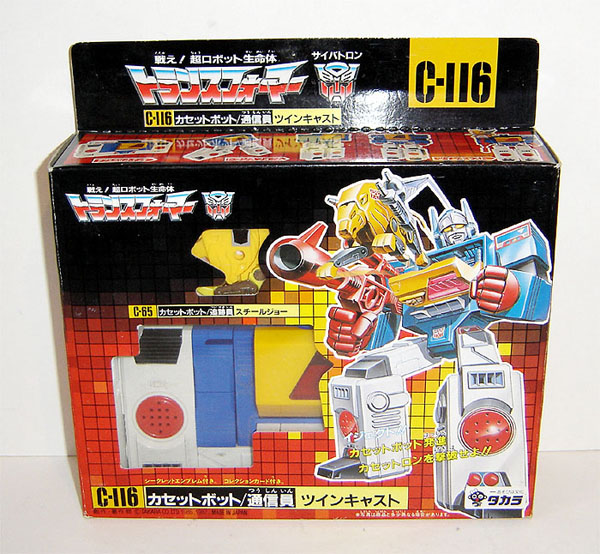
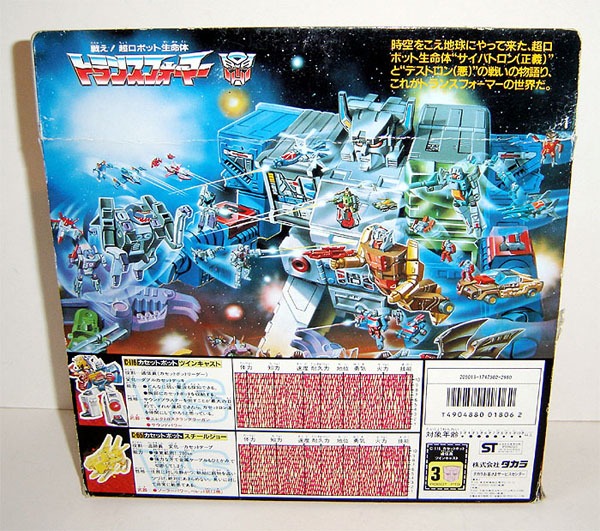
The box has a lovely look to it, extremely colourful and very displayable. Even though C-116 Twincast is a re-colour/re-tool of Broadcast (Blaster’s Japanese TF name), his boxart is not just a simple re-colour. Twincast sports new boxart with Steeljaw on his shoulder. The reason Steeljaw is included in the boxart is because C-116 comes packaged with an exclusive special version of C-65 Steeljaw only available with this release. Twincast’s Steeljaw has a small sticker on him that outlines Scorponok’s weaknesses.

Here are the C-116 contents and styrofoam insert:
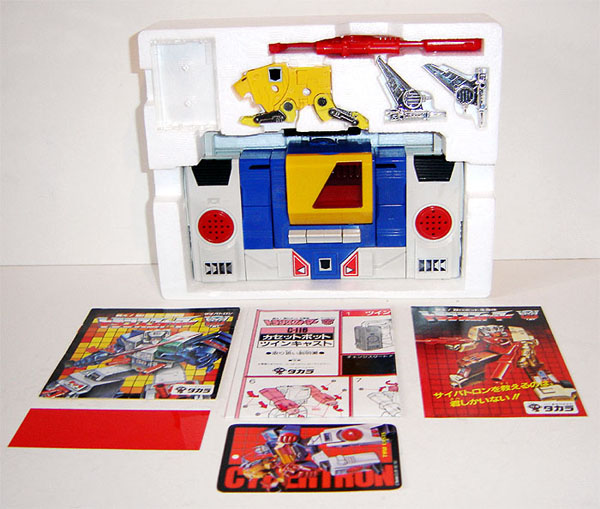

The main insert has a very smart looking Styrofoam layout. From the above picture you can see Twincast’s re-coloured red handgun (Blaster’s was black) and the clear tape case that comes with many Japanese release cassettes. Twincast also came with a lovely collector’s card.

I’ve always liked toys with articulated necks, but Twincast/Blaster’s
articulation and posability have never matched Soundblaster/Soundwave’s
and he’s always had a very blocky look to him. As mentioned before,
Twincast can hold two cassettes in his chest which is a nice feature added
to these toys.
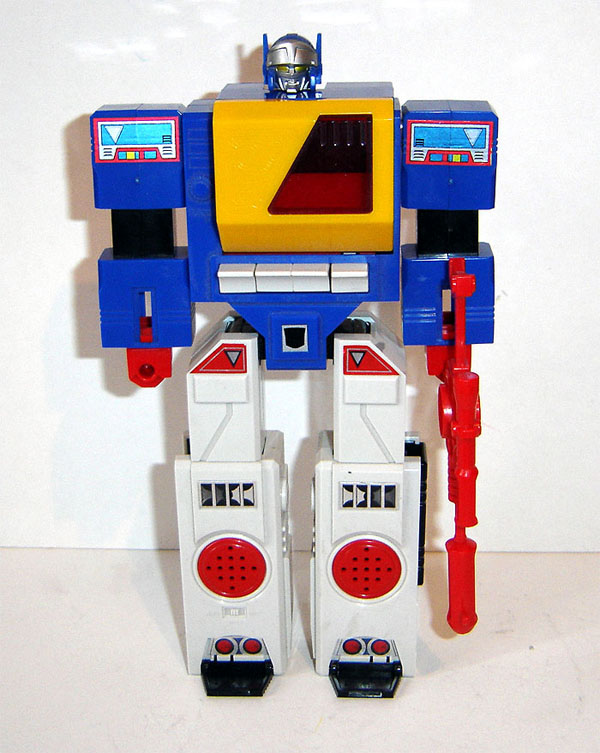

Twincast's figure mode is equally as striking as his player mode, and a good deal larger than his Decepticon/Destron counterpart. As with Blaster, care must be taken when using the buttons on Twincast's chest when ejecting/inserting the cassettes into the deck.


Now this is where things start to become a bit more interesting! If you look at D-101 Soundblaster’s boxart, he’s holding almost exactly the same pose as Twincast. In addition to that, he has Buzzsaw on his shoulder. Buzzsaw has been designated as D-106 but he was never available separately. One of the nice things about both Soundwave and Twincast is that the boxes are both the same size and display very well. Twincast’s colours are very Autobot-representative and so his box/boxart/figure colour combination makes for a great sight when you view the front of the box. The same can be said for Soundblaster whose colours are very Decepticon-representative. Just like Twincast, Soundblaster’s box has both his own techspec on the back as well as his cassette companion’s. The two players are definitely a set.
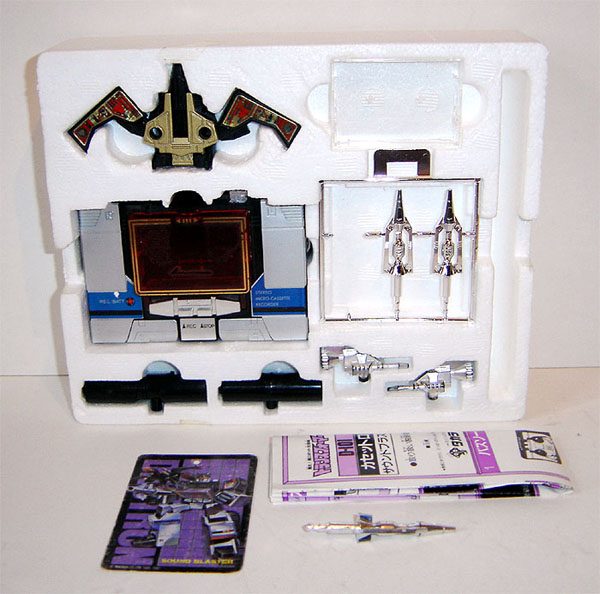

Another very smart-looking layout for the styro insert. Just a note about the second picture, the back of Soundblaster’s styro has his designation D-101 imprinted on there which is a common feature for all Styrofoam-containing Takara TFs released during the Headmasters period. All of Soundwave’s original accessories are present but in black (except the missiles obviously!). Soundblaster also comes with a clear tape case for Buzzsaw. The Buzzsaw released with the D-101 set also has an exclusive sticker, this time detailing Fortress Maximus’ weaknesses, which can be seen below.


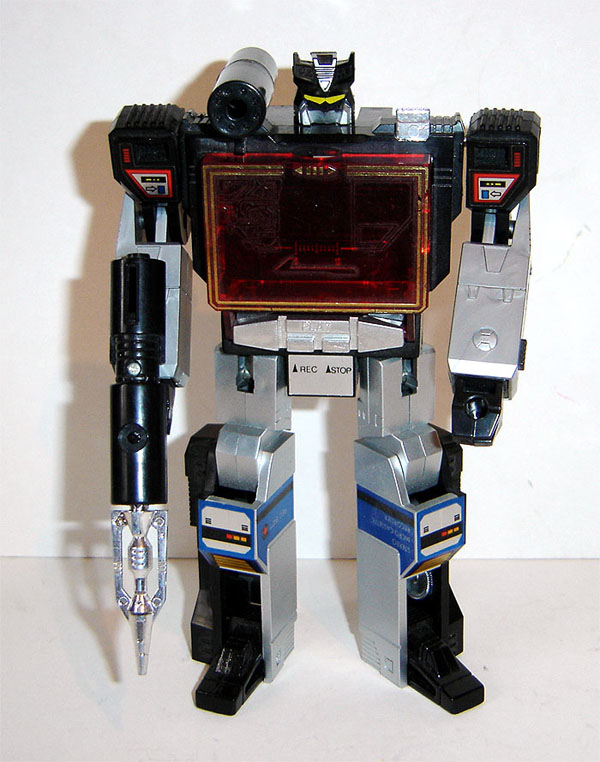
Soundblaster’s re-tooled chest section stands out in the above pictures. Not only can it hold two cassettes, but it’s also a very fetching translucent red! There are a couple of interesting features that should be noted. Firstly, Soundblaster’s rubsign is not on the tape door as it is with Soundwave, it is instead on his Soundblaster’s left arm. Secondly, the tape-door design and chromed ‘buttons’ underneath the door are unlike the US release of Soundwave but much closer to the Japanese release of Soundwave. The hinges at the bottom of the tape door are on the outside on the Japanese release Soundwave and Soundblaster, but the US release Soundwave has those hinges on the inside. Now look at the tape ‘buttons’ underneath the door because US Soundwave’s are a different shape, more triangular and separate from the central ‘buttons’. Soundblaster’s are more trapezium-shaped and are connected to the central ‘buttons’ which again is like the Japanese release of TF Soundwave. So not just proof of US Soundwave-Soundblaster variations, but of US Soundwave-JAPAN Soundwave variations. The next picture provides a visual comparison of a US Soundwave and Soundblaster and the difference can be seen.
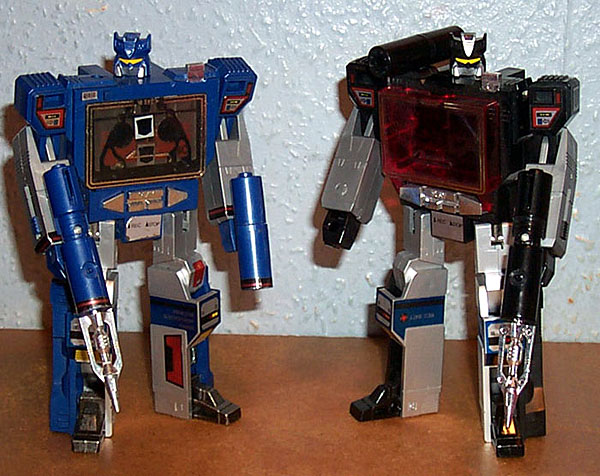
Soundblaster also comes with a lovely collector’s card, one of my favourite features of the Takara TF line.

Here is a picture demonstrating the double cassette-holding capability of these retooled toys:

That covers pretty much all I wanted to say about the players, now I want to move onto the Japanese exclusive cassettes that accompanied the above releases. Takara created four new cassette moulds, all Autobots, which could combine to form mini cassette gestalts. They were also dinosaurs, hence the name Dinocassettes. If you look at Curt’s collection page on TFSource.com you will also see these referred to as “W Cassettes” where “W” stands for double in Japanese. You can see the “W” on the box front in the name/function bar next to the C-number.

C-121 is Gurafi (sometimes called Graphy) and is a pterosaur/pteranodon/pterodactyl etc, C-122 is Noizu (or Noise) and looks like a Tyrannosaurus Rex, C-123 is Dairu (or Dial) and looks like a Velociraptor/thunder-lizard type thing and C-124 is Zauru (or Saur) and looks like a brontosaurus. C-121 and C-122 combine to form Decibel whereas C-123 and C-124 combine to form Legout. As you can see, they look pretty nice displayed together.
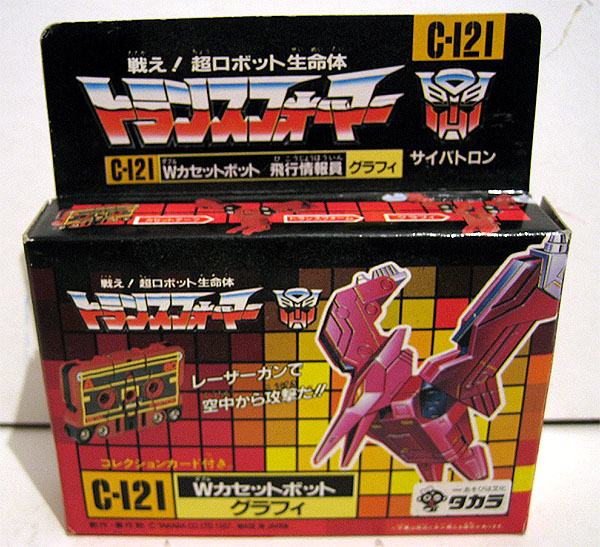
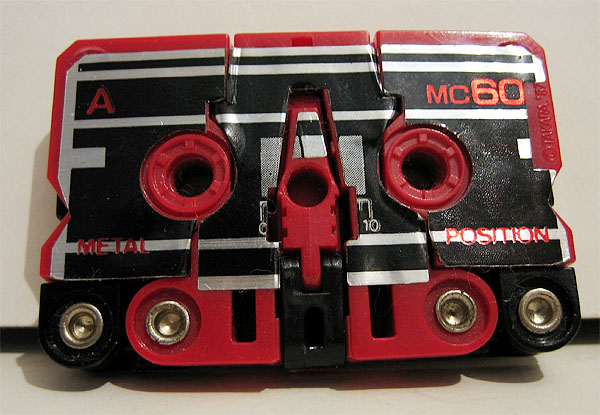
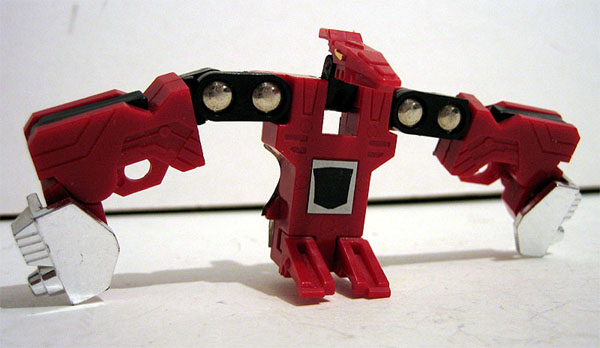
Gurafi is a bit like a mini-Swoop. These are very well engineered despite the fact that their alternate modes are not always particularly pleasing to the eye. Gurafi however doesn’t look bad in either mode. You can see the cool art for the combined Decibel on his box back and the techspec is on the bottom of the box. These cassettes do not come with clear plastic tape cases.
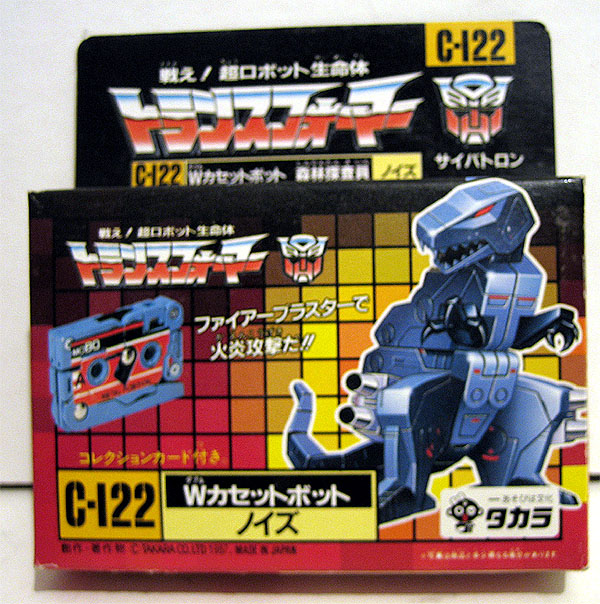
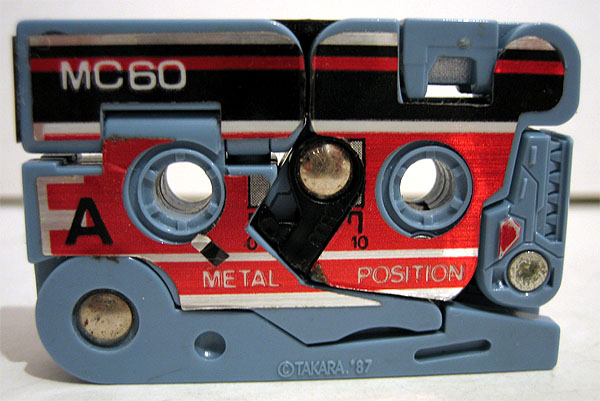
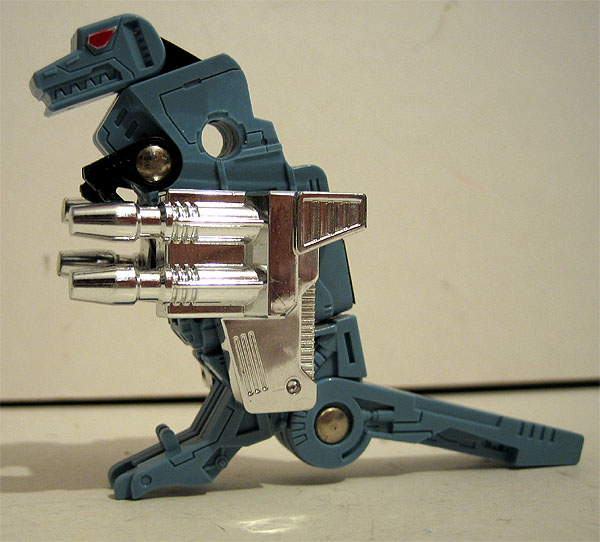
I have to say that I’m not too fond of how Noizu looks in dinosaur mode despite having striking box art and being quite a nice colour. I feel his dinosaur arms are just way too small and he looks terribly hunched. His weapons are quite large relative to himself as well.
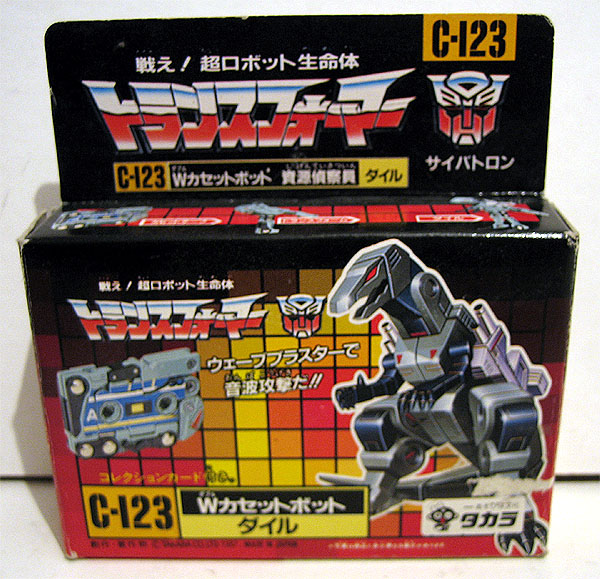
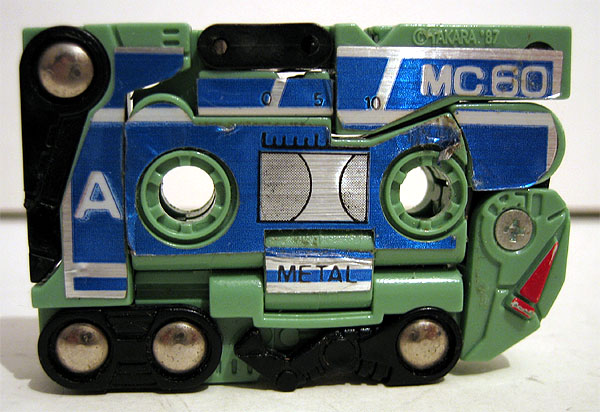

Dairu is probably my favourite cassette as far as alternate modes go (see collective picture below). Again, lovely boxart in evidence and the combined form of Legout has his own art on the box back. I also really like how his weapons in dinosaur mode look like a rocket pack. The art on the box shows Dairu to be more grey than the toy, which is far more green. This particular one is probably the rarest of all four, but not rarer than C-124 Zauru (Saur) by a long way, not at all.
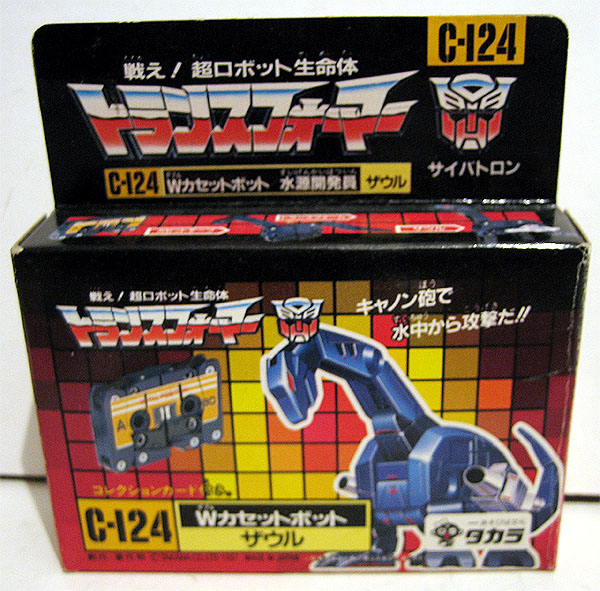
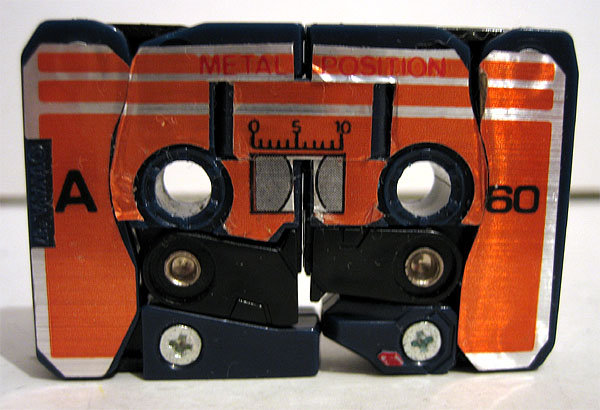
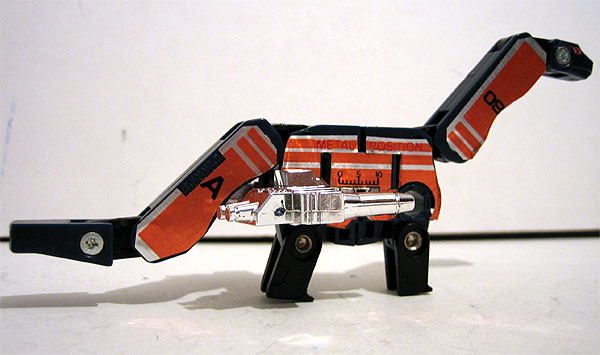
I feel that Zauru probably for me doesn't have the strongest alternate mode despite having one of the nicer cassette modes. It has grown on me in time however, especially if you catch him from the right angle he can look majestic as a brontosaurus should. He also has a lovely blue colour to him and the boxart remains impressive. Here’s a picture of all the Dinocassettes in dinosaur mode, accompanied by Decepticon cassettes Slugfest and Overkill:
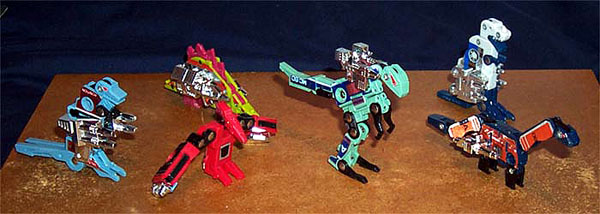
The rubsigns on C-121 through C-124 are custom additions and do not come as standard. To be honest, the bad ones aren’t THAT bad and the two good ones are nice to look at. I think the lovely boxart is slightly misleading and builds up expectation. It is possible that since Dairu and Zauru are so hard to come by, once someone pays the high asking price, a collector might have expected more for their money. Here are some pictures of the combined forms, first Decibel (Gurafi + Noizu), then Legout (Dairu + Zauru):
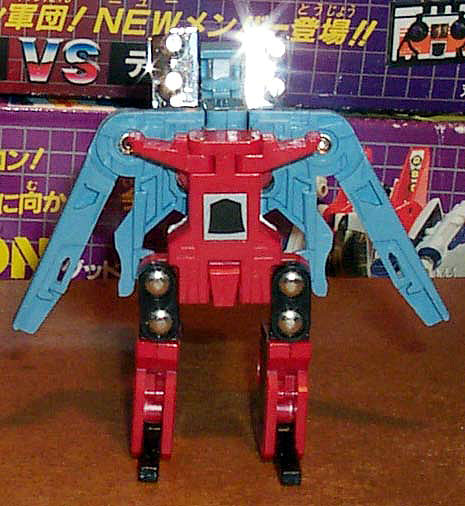

Again, not much to look at. There isn’t a great
deal of detailing on either of them and as a result they look a tad dull.
However, I have to say that it’s still a neat feature that you’ve
got cassettes, reasonable-looking dinosaur modes, and combined modes that
definitely do resemble robots. Legout’s robot head is much more
detailed and far more impressive as a result. Decibel’s arms don’t
look as good as Legout’s either, but then Legout’s don’t
look that great anyway! As I said before, the boxart paints quite a different
picture…

So overall, as far as the players are concerned, you’ve got a couple of beautifully packaged and presented toys which are more than just a re-colour. The added features that come with Twincast and Soundblaster make them excellent toys to own, but probably not for the prices they tended to go for before the reissue Soundblaster hit. I wouldn’t call them particularly rare any more though. My main problem with those two is that Blaster/Twincast has always been so much bigger than Soundwave/Soundblaster, making for limited display possibilities. The Soundblaster mould in my opinion is by far the superior, boasting excellent posability and a much sleeker sophisticated look.
As for the cassettes, they are also beautifully presented. Gurafi and Dairu are nice toys with strong dinosaur modes, Noizu and Zauru look better as cassettes and the combined modes don’t look particularly good at all, but you have to appreciate the design and the attempt. All of the above toys come with impressive collector’s cards that add to the display value greatly. Dairu and Zauru tend to be prohibitively expensive since they turn up so infrequently, and that’s a shame for collectors because many love the cassettes. At the moment, you’re looking at quite a payout if you want to get your hands on Twincast, Soundblaster and all the associated cassettes. It’s not impossible that all these toys are strong reissue candidates for Takara some time in the not-too-distant future, excluding Soundblaster of course which has already seen reissue as TFC #18.
I’m going to leave you with a couple of very nice pictures that really show how beautifully these toys can be displayed when packaged, because for a few of the toys mentioned here, the packaging is the best feature.
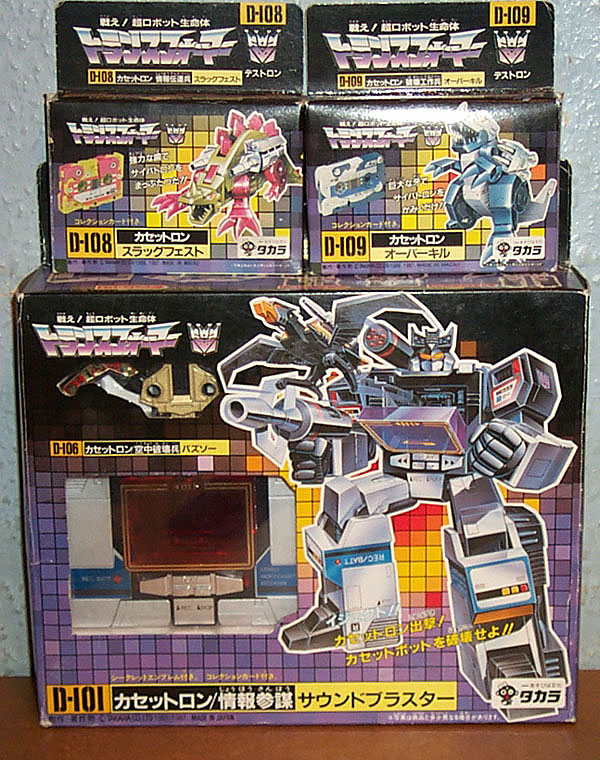

Many thanks to Rickie for providing the toys for the photos.
All the best
Maz












